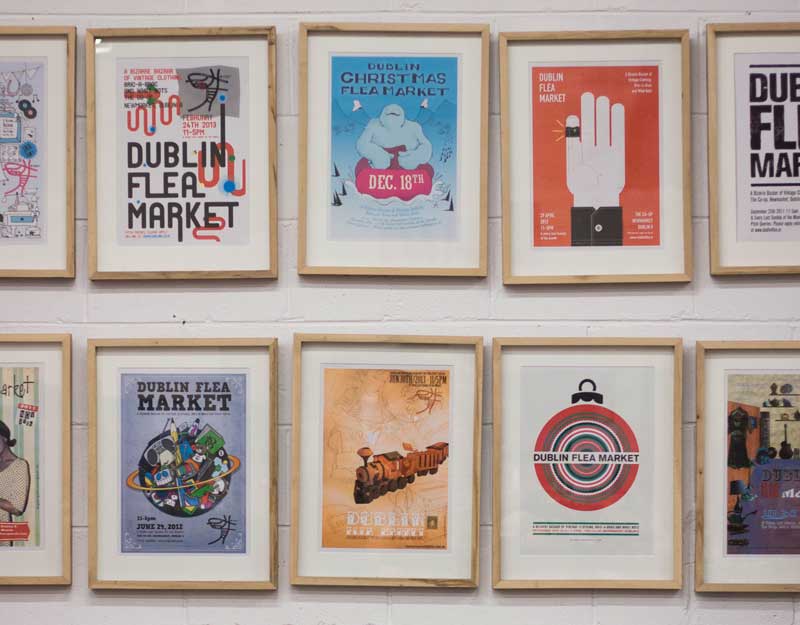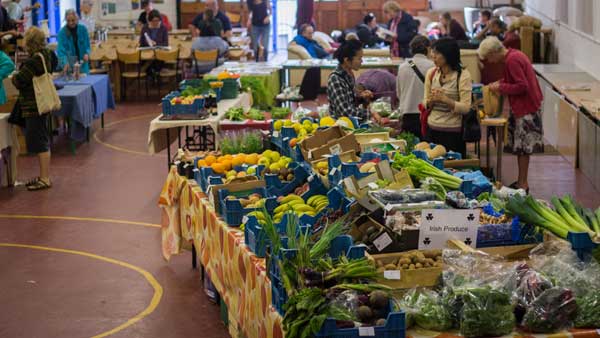
It is a sunny Sunday afternoon, the last Sunday of the month, which can only mean one thing – a trip to the Dublin Flea Market. A monthly visit there can find the flea thronged and vendors running out of falafel. One loses a sense of time amidst the stalls and stands that contain hidden gems waiting to be uncovered. From retro furniture to vintage fur, there’s something for everyone to be found at the flea.
But this Dublin establishment has recently come under threat by plans for new development. The Newmarket Partnership are the developers behind the projected refurbishment of Newmarket Square. They have proposed the demolition of the 1970s enterprise centre, as well as work on Mill St as part of a Liberties regeneration scheme. Included in their proposal are plans for an indoor market space, a micro brewery, retail and office space, a hotel and residential accommodation. This would replace the space currently occupied by the Dublin Food Co-op, the Green Door Market and the monthly flea.
The Dublin Flea Market is a not-for-profit social enterprise that promotes sustainability and opportunity in the wider community. It is about innovation, entrepreneurship and collaboration, as well as snagging great deals by haggling and making friends. Speaking to The University Times, Sharon Greene, the co-founder and manager of the Dublin Flea Market, explains why the flea is important and how its closure would negatively impact not just those who are involved in it, but the entire community.
Newmarket began creating a legacy of a creative and market hub. It really became this ‘creative quarter’ in the city and it drew a lot of people into it
“We’ve been running [Dublin Flea] for the last Sunday of each month since 2008, for the last 9 years”, says Greene. “We were instrumental in changing by-laws to reintroduce Newmarket as a designated trading area, because it historically was always a trading area.” Newmarket has been underdeveloped for a number of years, as it seemed to have been bypassed by the last boom. The low-rental economy in that area meant that creatives like Greene were drawn to this place as they could afford to set up shop. “Newmarket began creating a legacy of a creative and market hub. It really became this ‘creative quarter’ in the city and it drew a lot of people into it,” says Greene.
“It’s very community orientated as it’s very residential in that area. Places like the Fumbally and South Studios make Dublin 8 a creative crossroads for all these artists to gather and meet. Something really exciting and special is in that area.”
The area is under threat from the aforementioned Newmarket Partnership, as their proposed “market space” is roughly the size of a shop and certainly not big enough to facilitate the needs of the flea nor the four other sub-leasing indoor markets that share the space. “The occupancy of any of the [new] spaces is uncertain because it’s in private ownership. It is basically down to the developers themselves who they let their units out to. So on one hand there is a legacy of the creative and market hub that grew up over the last 15 years that has lent Newmarket a very strong, cultural character and then on the other hand there’s the fact that the developers are totally within their right, in a way, to develop their own property however they like and rent it out for as much rent as they can get”, Greene explains.
This legacy instills Newmarket with a very strong identity as an area and this has massively contributed to its “re-birth”. With money flowing back into the capital, it’s only natural that developers are looking for opportunities for growth. Newmarket is an extremely attractive area to facilitate this. However, more offices and retail spaces drive Dublin’s creatives and artists further and further outside of the city centre.
“In the three planning applications that are pending, only one artist’s studio is proposed”, says Greene. And it’s not only Newmarket that highlights the drain, Millstreet is being turned into student accommodation and much of South Studios are being rebuilt as apartments. “At the moment we’re just looking at New Market, but a few feet away we already see the loss of creative hubs, you can see the dissolving of a very unique character which has evolved and flourished over the last few years. And now it’s looking like if there isn’t space given over to the market in the new plans it may also disappear”, says Greene.

A story familiar in other cities, Dublin can now expect an area that once boasted a strong cultural, quirky identity to be homogenized by corporations and offices, with displaced creatives fleeing elsewhere in search of affordable rent.
Dublin’s creatives, we’re often told, are the people who make the city special, who give it that exciting element that sets us apart from other major European capitals. “Newmarket could be a shining example of new modern development within a city quarter that has community at its heart. Development doesn’t have to progress by leaving the existing residents at a loss. There could be space for everyone!”, Greene says optimistically. Essentially the flea market supports the redevelopment of the square, although it wants it to be done in a way that preserves the artistic community, as they themselves first began the regeneration of this area.
Perhaps the answer to this problem is a more thoughtful, community-conscious approach to development. Dublin’s tourism relies heavily on its reputation as a vibrant, culturally rich capital. Other cities are rapidly becoming more attractive to the global creative class as they offer higher standards of living at cheaper rates. In Europe, the leaders are Berlin and, more recently, Lisbon. These cities tackle this problem by supporting thoughtful development through the use of rent caps, levies and subsidies. These could be implemented alongside incentives for renting to creative communities in Dublin to help keep the city’s creative soul thriving.
At the moment we’re just looking at New Market, but a few feet away we already see the loss of creative hubs, you can see the dissolving of a very unique character which has evolved and flourished over the last few years
A quick glance through the approved planning appeals on the website of An Bord Pleanála show just how much of the city is soon to be under reconstruction. In the same district as Newmarket, the Dublin City Council are seeking to reclaim the Edwardian Iveagh Markets, after plans of building a hotel, restaurant and food market complex have not been realized. Another hotel, another restaurant. Dublin is on the brink of yet another building boom. According to the most recent report conducted by Savills Ireland, “just under 14,000 sqm of new office space was built in 2015, compared with a further 62,310 sqm completed in 2016. In 2017 we see activity ramped up dramatically again with 70,116 sqm of completions”. This figure is expected to continue to rise well into 2018. The question is: will Dublin’s artistic community be given adequate space or will it slowly be pushed further and further afield?
One only has to visit the petition page of the Dublin Flea, which surpassed its signature targets by more than double, to read passionate statements of solidarity written by fellow creatives, fans and visitors from further afield. When asked his thoughts about the impending threat and how places like the flea are vital to the artistic community, designer Ian Walton of watch brand NTN told The University Times his concerns by email. “From my perspective Dublin 8 is one of the few remaining areas in the city in which interesting/creative endeavours can still take place — certainly in the south of the city. We could not have created our shared studio space and experimented with our open Fridays without an area which is both affordable and open to new ideas. The particular strip from the Thomas St end of Francis St through to Newmarket square is a hive of activity for young creative/artistic groups.”
The irony of it all being that D8 is experiencing this ‘growth’ thanks to things like the flea
He continues to address the flea directly: “The flea and the ripple effect created by it’s presence is really the cornerstone of this community. For me it signifies the fact that this area is still culturally diverse and active as a community. Without it you can’t help but think that its environs will slip towards a much more homogenised version of itself in which nothing interesting really happens. The irony of it all being that D8 is experiencing this ‘growth’ thanks to things like the flea — the developers don’t seem to realise that they are poised to destroy the very things that have brought their attention to the area in the first place.”
Nessa Finnegan has been selling her collection of Irish Fem Swag/Shop Nessa Finnegan at the Dublin Flea for almost a year now. Speaking to The University Times, she tells of how important the flea is and what it means to her as a young creative: “My fear is that Dublin City will become inhospitable for creatives. Affordable spaces such as Newmarket Square allows people, myself included, the opportunity to develop creative businesses and communities as well as providing scope for collaborative approaches that are vital in the creative industries.”
Finnegan continues: “These spaces and how they are used by Ireland’s ingenious creatives greatly contribute to a city’s culture, vibrancy and beat. I am worried that through a major new development this important contribution will be left as an afterthought and that spaces like Newmarket Square will disappear, along with it artists, designers and a big chunk of Dublin’s culture, vibrancy and beat.”
If we lose the flea we don’t just lose deals on dressmaker’s patterns, china teacups, slips made from satin, an entire black tux, silverware and retro chairs. We lose a Sunday’s outing with friends and friends of those friends. The flea welcomes all, not just bearded hipsters in tight fitting jeans sporting asymmetrical, side-swept fringes. There are old families and young families, tourists from afar and proper Dubs from just down the road. The flea is a place to congregate and catch-up as well as a place to begin new relationships. It is an establishment, a deeply embedded Sunday’s routine. If not for the knick-knacks, we go for the people.






